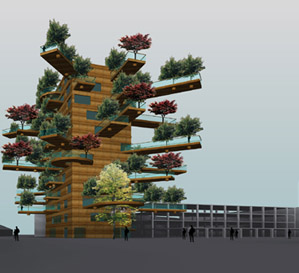 Big and Green
Big and Green

환경친화적 건축의 사례들 중 많은 것들이 이미 자연환경이 잘 보존되어 있어서, 질 좋은 자연조건들을 아주 잘 활용할 수 있는 곳에 자리잡고 있었습니다. 그럼 상대적으로 환경적 질이 낙후되어있는 도시에서는?
복잡다양하고 활기찬 도시의 장점을 살리면서 동시에 환경에 대한 영향을 최소화하려는, “밀집도시(compact city)”로 대표되는 환경친화적인 도시만들기가 이에 대한 대안으로 등장하고 있습니다.
세계화로 인해 유동성이 극대화되고, 결국 밀려드는 인구로 유례없이 확장일로에 있는 거대공룡의 몸집을 유지하면서 환경의 질을 동시에 높이려는 win-win 전략은 과연 성공할 것인가?
그에 대한 질문과 다양한 대답들이 National Building Museum(Washington)에서 열립니다. 전시회 내용은 같은 제목의 책으로 엮여 있습니다.
BIG & GREEN
TOWARD SUSTAINABLE ARCHITECTURE IN THE 21st CENTURY January 17 - June 22, 2003
Many cities around the world are experiencing intense, even explosive growth that often poses a significant threat to the natural environment. The skyscrapers and other "megastructures" that are commonly built to accommodate such growth consume enormous amounts of energy in their construction and day-to-day use, place great burdens on water and sewer systems, and typically isolate occupants from natural light and air.
Nonetheless, many architects, engineers, and planners believe that large, densely-packed urban buildings, when properly designed and constructed, represent an inherently "sustainable," or "green," form of development. That is, they can actually minimize negative impacts on the environment while protecting the health and well-being of their occupants. To achieve these goals, building professionals are increasingly resurrecting strategies that were routinely employed in smaller structures in the past - such as natural ventilation and shading devices to reduce heat gain - and adapting them to larger and more complex buildings. Meanwhile, they are exploiting new technologies, from solar power cells to sophisticated wind turbines, to create a new breed of large-scale buildings that are both comfortable and environmentally benign.
Big & Green: Toward Sustainable Architecture in the 21st Century explores five categories of issues that design and building professionals are addressing in order to reduce the deleterious environmental impact of skyscrapers and other megastructures: Energy; Light and Air; Greenery, Water and Waste; Construction; and Urbanism. The exhibition demonstrates that, through thoughtful design and careful management of the construction process, even the largest structures can further the cause of a more harmonious integration of the built and natural environments.
Architecture Unplugged: ENERGY
The profligate consumption of fossil fuels is one of our biggest environmental problems today. The insatiable demand for fossil fuels results in air pollution, water pollution (due to oil spills), and often. We may think of cars and factories as the most obvious enemies of the environment, but buildings consume more than half the energy used worldwide. Mechanical networks that supply air-conditioning, heating, lighting, and other building systems are now being redesigned to consume less energy, while alternate sources of energy are also being developed. As more and more communities are offering building owners the opportunity to purchase energy made from renewable or clean sources like the sun and wind, many architects are now designing buildings that generate their own energy.
Buildings that Breathe: LIGHT AND AIR
Before the development of efficient artificial lighting, heating, and cooling systems in the 20th century, access to fresh air and daylight was a primary determinant of building form. In the last fifty years buildings have increasingly relied on mechanical systems for their light and air. Some contemporary architects, however, are once again promoting the importance of natural systems. They are designing large-scale buildings illuminated by the sun and naturally ventilated with double-skin windows that let in air but keep out noise and heat. Strategies for natural ventilation and illumination are now becoming more widely accepted as architects and engineers develop advanced techniques for providing natural air-conditioning in buildings of unprecedented size in the hottest of climates, as well as reviving older, forgotten strategies.
We Can Rebuild It: CONSTRUCTION
The materials used to construct large-scale buildings-concrete, steel, wood, plastics-all create environmental problems because of the energy used to fabricate them, the toxic chemicals that make them attractive, waterproof, or fireproof, and the energy needed to transport them. Some architects and engineers concerned with environmental sensitivity are now employing a variety of strategies to limit the environmental impact of building construction. Among these solutions is the reuse of existing buildings through adaptive reuse, which is a form of recycling on an architectural scale. For new construction, architects can better control the use of materials and reduce waste by utilizing materials that require little energy to produce and ship, are renewable, modular and prefabricated.
Green Giants: GREENERY, WATER AND WASTE
Greenery inside and outside of buildings is a crucial part of the cycle of water consumption and waste. Understanding this relationship is important, as architects attempt to curb water consumption, reduce waste water, and use natural plant materials to mitigate the impact buildings have on their surroundings. Large buildings can consume millions of gallons of water a day, while during a single rain storm millions of gallons can be lost, as untreated water runs off into sewers or the ground. Engineers and architects are now collaborating to develop ways of using this run-off as undrinkable "gray" water in sinks and toilets. Greenery cleans our air by converting carbon dioxide into oxygen, and cleans our water by filtering run-off water before it is released into the surrounding environment.
The Emerald City: URBANISM
Cities are themselves complex systems, and there is no one formula for making cities vibrant and livable. Strategies to manage growth, to preserve green space, and to regulate building to promote environmentally sensitive development are finally beginning to appear in American cities. One notable example is the sustainable development codes written for the Battery Park City Authority in New York, which regulate energy conservation, air quality, water conservation, and material use, and promote pedestrian activity and public transit use.
전시회
http://www.nbm.org/Exhibits/current/Big_and_Green.html
강연회
http://www.nbm.org/Events/Calendar/Big_and_Green.html